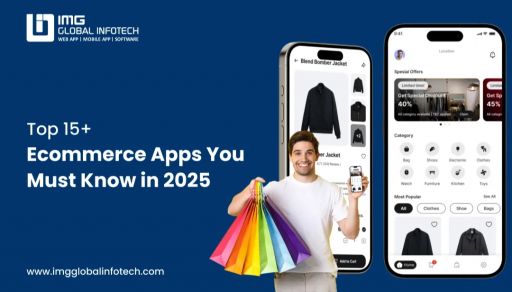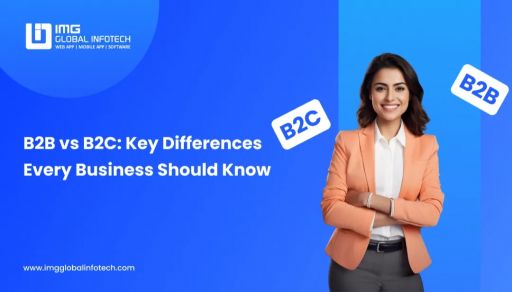B2C Ecommerce Website Development: Complete Guide
Mohit Mittal
Nov 26, 2025
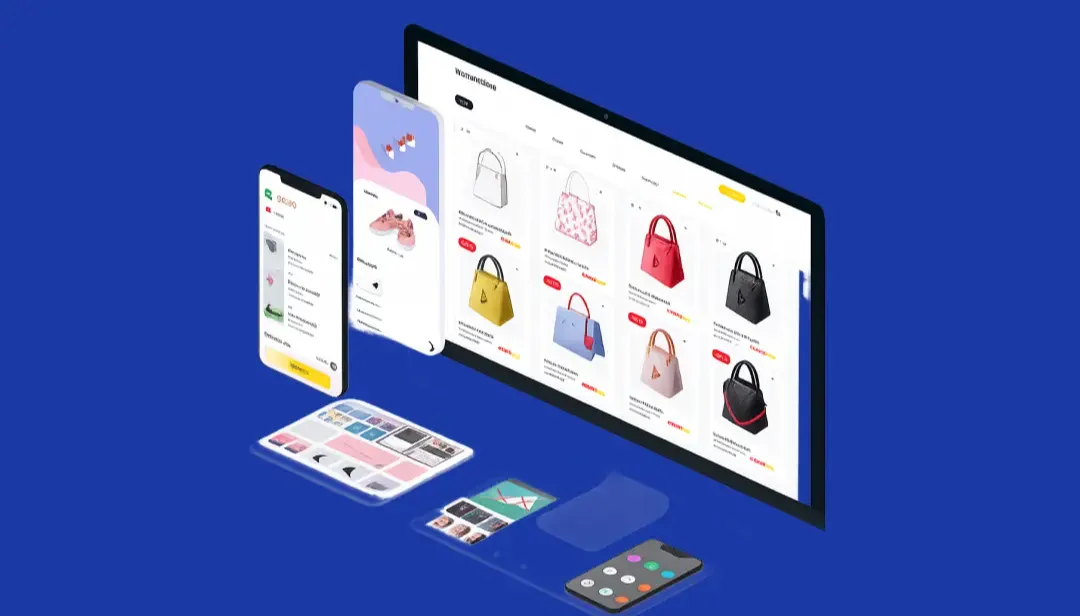
This is the era of digitalisation, and a lot of modern technologies have taken over the world's ecosystem. Nowadays, people want comfort, convenience, personalisation, and speed regularly. Due to this behaviour change, the e-commerce industry is growing at a rapid pace. More and more customers prefer digital shopping rather than the traditional way of going to a physical store. With these buying habits, the brands are switching towards building online stores that deliver speed, personalisation, and convenience. It is the case of b2c ecommerce website development as it is now the backbone of achieving digital success.
Whether you are a new company or a startup, or a company that wants to upgrade and is trying to enter the online market, you need to have a proper understanding of features, tech stack, integration, user experience, and the required cost. A well-designed B2C platform can help businesses boost conversions and also stay ahead in the highly competitive space.
This B2C ecommerce website development guide will walk you through the market trends, types of B2C websites, and must-have features. This blog will also give you the information regarding the development steps and cost, and everything you need to know to develop a high-quality online store in 2026. So let’s begin.
B2C Ecommerce Websites Market Stats
The businesses that are heading towards the b2c ecommerce website development process need to know the market stats. They must understand that the e-commerce sector is becoming more and more dynamic as time passes. Let us now see the Grand View Research report in this space.
-
As per the Grand View Research report, the global B2C ecommerce market was valued at $5.47 trillion in 2023.
-
The projection of the market to reach by 2030 is $17.77 trillion. It will grow at a CAGR of 19.1% from 2024 to 2030, as per the estimation report.
-
The Asia-Pacific accounted for a huge market, about 58% of the global B2C ecommerce revenue in 2023.
-
With a CAGR of 15.5%, the US B2C ecommerce market is also growing from 2024 to 2030.
-
The reports have projected a CAGR of 23.8% from 2024 to 2030 for India.
-
Clothing and Footwear are expected to take a big share of the whole market, with an estimated 21% CAGR.
-
If we look at the broader picture, the overall e-commerce market size was valued at $25.93 trillion. It is expected to reach $83.26 trillion by 2030, at a CAGR of almost 19%.
Points To Be Noted
-
The number of buyers who shop online is increasing year after year.
-
Mobile commerce accounts for more than half of the whole online shopping space.
-
AI-driven personalisation and automated product recommendations are a new normal.
-
Fast delivery, simplified checkout, and omnichannel experiences are changing user expectations.
One thing is for sure: the businesses that invest in modern B2C ecommerce platforms will have an edge over their competitors in this huge market.
Types of B2C E-commerce Websites
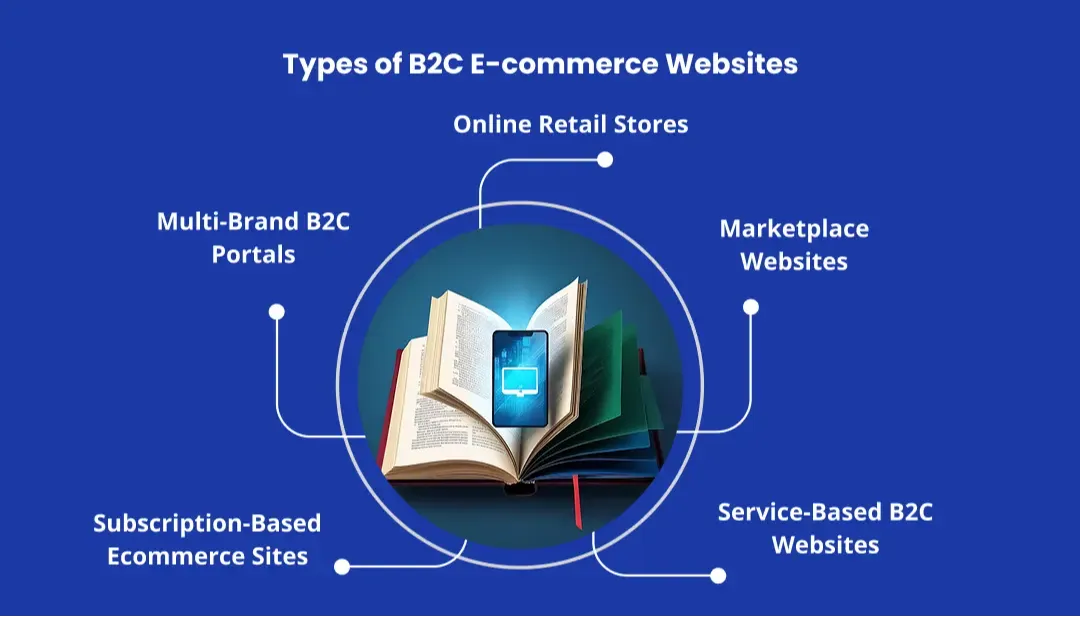
Choosing the right B2C business model is crucial to succeed in b2c ecommerce website development. The industry first analyses its product range, audience behaviour, and business goals and then uses the structure. Let us now see the different websites in B2C ecommerce.
Online Retail Stores
The number of online retail stores has increased over the years. Even the offline retail owners have moved to this space after seeing the trend. It is a direct-to-consumer (D2C) space where businesses sell products through their own website. The website could be of any space, like multi-category stores, niche stores, or brand-specific stores. Some of the prime examples are fashion stores, electronics shops, clothing brands or beauty product stores.
Marketplace Websites
Marketplaces are a powerful source, but they also require advanced features, modern technology, and infrastructure. It is also a powerful tool for scalable b2c ecommerce website design and development. A marketplace like Amazon, Flipkart, etc, connects multiple vendors with customers. A customer can choose which brand they want to buy a particular product from.
Service-Based B2C Websites
Now, let us take an example for this one. You are sitting at home, and your car needs to be repaired. Instead of going to the car repair shop, you have access to the e-commerce app that provides car repair service at home. You just have to take out your smartphone and request a service, and the car repair guy will be at your doorstep in just a few minutes. That is what a service-based B2C website does. It does not sell products, but provides services. Through these apps, you can book a salon appointment, consult doctors online, and get more of these professional services. These websites or apps also required an appointment, scheduling, calendar integration, and a geography-based search option and filter.
Subscription-Based Ecommerce Sites
Subscription model-based websites are on the rise. It is booming and is a very useful way for businesses to rely on recurring revenue. For example, if you are at your workplace and do not have time to cook something for yourself while craving, just order something from these apps and surprise: here comes your tasty food to vanish your cravings. Another example could be: if you are getting ready for an event and want to have your makeup on, you can book an expert from the field and get things done. These are the things which you do normally in your life and require every day. So having a subscription to these things will help you to be on top, and you will not miss out on anything.
Multi-Brand B2C Portals
These portals are similar to marketplaces, but differ in a few ways. It hosts collections from different brands under one store. Here, the portal owner dictates terms as they only control product listings, pricing, and inventories. The consumer can buy a particular brand’s product after comparing it with other brands' quality and pricing. Choose an Ecommerce development company who are experts in building multi-brand B2C portals.
Considering these aspects is important to ensure that the features of a B2C ecommerce website match your long-term business goals. Before the development process, understand these models for an effective strategy for an online store.
Essential Features for B2C Ecommerce Website Development
A good quality B2C website must have usability, functionality, and the ability to convert design. These things will increase customer experience, speed up their buying decisions, and eventually lead to overall business growth. Here are some of the most important features for your b2c commerce website development.
Mobile-first Responsive Design
A large number of people shop online, and more particularly via smartphones. Your website design should respond to the customers' seamless browsing across devices. It will also improve your SEO (Search Engine Optimisation) rankings, which will help your brand reach a wider audience.
Intuitive Navigation and Smart Search
A menu page of your website should be easy to use for the users. They should be able to filter out things and reach the desired products within seconds. Sorting options and predictive search create a frictionless user experience. For example, if a user is looking for clothing, they should be able to filter out the price, sizes, and brand.
High-Quality Product Pages
The product pages on your website must include clear images, videos, specifications, reviews, and comparison options. The description part of the page should be clear and give proper information to the potential buyer. There should be a video which shows how to use the product, their prices, specifications, and other relevant information. All this information helps the customers make informed decisions.
Easy Checkout
Cart abandonment is a common problem in e-commerce platforms. Your ecommerce website or app should have a one-page checkout without any delay. It reduces the cart abandonment problem and provides security. The platform must also support multiple payment options like UPI, debit or credit card, BNPL wallets, net banking, and Cash on Delivery (COD). With multiple payment options, customers feel secure and can pay as per their convenience.
Shopping Cart and Wishlist
Sometimes a user explores the products on the ecommerce platform for future purchase. They were not in a position to buy that particular product for whatever reason. But they should have an option to add that product to their cart or wishlist so that they can come in future and have a go at it again. Having a wishlist option improves customer return rates. It is a must-have tool for any modern ecommerce platform.
Account Dashboard
The customer nowadays has the option of checking their order history, saved items, address and coupons. They have their own dashboard, which makes things easier for them to find their wishlist, what they have ordered in the past, what products they have returned, and other relevant information. It helps them make informed decisions. Hire ecommerce developers who have the expertise in building an account dashboard so that the customers will have a seamless experience.
AI-Powered Personalisation
In this modern era of technology, AI recommendations and personalisation are important features to have in your ecommerce store. The technology has the ability to see the consumer’s previous purchases, their product search history, and regularity in buying the products. With analysis, the platform can recommend the products, dynamic pricing, and tailored promotions to the customers. It will significantly improve conversions and eventually generate more revenue and profits.
Order Tracking System
The customer can track the order and see the time of arrival of their delivery. It will reduce support queries from the customer’s side. The customers want transparency, and this way, they feel secure and transparent.
Reviews and Ratings
Having the authority to give feedback from the customers is helpful for both the customers and the business owner. The customer can give ratings depending on their experience, and a business can improve things if there are any. From the next time, a customer will get the desired product. It builds credibility and positively influences purchase decisions.
Inventory and Product Management System
This feature is useful for business owners and those who manage day-to-day operations. It ensures smooth everyday operations like product uploads, pricing updates, and stock management. A strong backend system also helps in vendor coordination.
Analytics and Reporting Tools
The platform must have the features of analytics and reporting so that the business can see and understand the buying behaviour of the consumers. Based on the insights, a business can optimise its operations and rectify itself wherever needed. With the analytics tools, a business can see how much revenue came from a particular product, and from what part of the region or world.
SEO-Optimized Framework
Search Engine Optimisation (SEO) is a key to digital success in today’s times. Plan your website that be optimised for search engines. It will improve your brand’s visibility, engagement, and eventually, revenue generation.
Customer Support Features
Customers sometimes have a query on a particular point, like the delivery time, pricing system, size availability, and defective piece complaints. There should be tools like live chat, chatbots, and FAQs to solve their problem. The ticketing system will also help in this cause and enhance engagement.
Multi-Language and Multi-Currency Support
A business that operates in different parts of the world should have multilingual support for its customers. The different customers who live in different areas are more comfortable in their local language. As far as payment gateways are concerned, different countries have different currencies, and the business must know this aspect and provide multiple-currency support.
Steps to Build B2C Ecommerce Websites
B2C platform development requires proper planning, analysis, and strong execution. Whether you are a startup that wants to build a B2C ecommerce website or an existing store that wants an upgrade, the general process includes the following stages.
Requirement Analysis and Planning
Determining your business goals, target audience, product range, and revenue model is important before the process to build a B2C ecommerce website. The development team will also analyse the competitor’s approach and identify the gap. If there is any gap available, they will look to exploit it and see the opportunity to go ahead in the market.
Choosing the Right Tech Stack
As per the requirements, the usage of the tech stack will change. It also depends on budget, scalability, and complexity. Some of the options include Magento, Shopify, WooCommerce, React + Node.js custom development, etc. For a scalable b2c website development project, choosing the right stack is crucial.
UI/UX Design
UI plays an important role in the customer’s mind. A good and well-designed page keeps engaging the customers, and it helps in increasing the conversion rates. The development team makes sure that the aesthetics are good, and the design team creates wireframes, prototypes, and UI layouts. They will also have to pay attention to the user journey.
Backend and Frontend Development
The experienced developers will build core functionalities like product modules, checkout, admin dashboard, APIs, user accounts, and more. It is the heart of b2c e-commerce website development.
Integration of Third-Party Tools
Hire a B2C website ecommerce development company that knows third-party app integration. The platforms need third-party tools like maps, payment gateways, CRM, ERP, shipping partners, SMS/Email tools, etc, for smooth and seamless operations. For example, if a clothing brand is delivering a product to a customer’s place, a delivery boy/girl wants a map to reach the point.
Testing and Quality Assurance
The development company will test the platform and do a quality check for seamless future operations. They have the options of usability testing, performance testing, security testing, and mobile testing to ensure the platform runs flawlessly.
Launch and Deployment
After all the Shopify ecommerce development or website process, the company will launch the website in a secure hosting environment.
Post-Launch Support
Always look for ecommerce developers who provide post-launch support and long-term maintenance. They make sure that your website stays secure, optimised, and up-to-date.
Cost to Develop a B2C Ecommerce Website
The b2c website development cost in 2026 depends on the website type, platform choice, feature complexity, API integrations and level of scalability. It also depends on the experience of the development team and their location. Let us now break down the cost as per the level of a website.
Basic or Simple Website
The basic website costs less than the mid-level or advanced one with more features. It is good for startups or small businesses. The cost of a basic website ranges from $10,000 to $20,000.
Mid-Level Website
A mid-level website is good for a business that already exists and is looking to add more tools and features. The e-commerce websites, like the Shopify website development cost, could range from $15,000 to $30,000.
Advanced Website
The advanced features of websites will be costly for the business, but they are suitable for those that operate with full automation. Understanding the development cost for websites with more features will help businesses make informed decisions. It could range from $30,000 to $50,000.
Overall, the B2C ecommerce website development cost can range from $10,000 to $50,000, depending on the level.
Why Choose IMG Global Infotech for B2C Ecommerce Development?
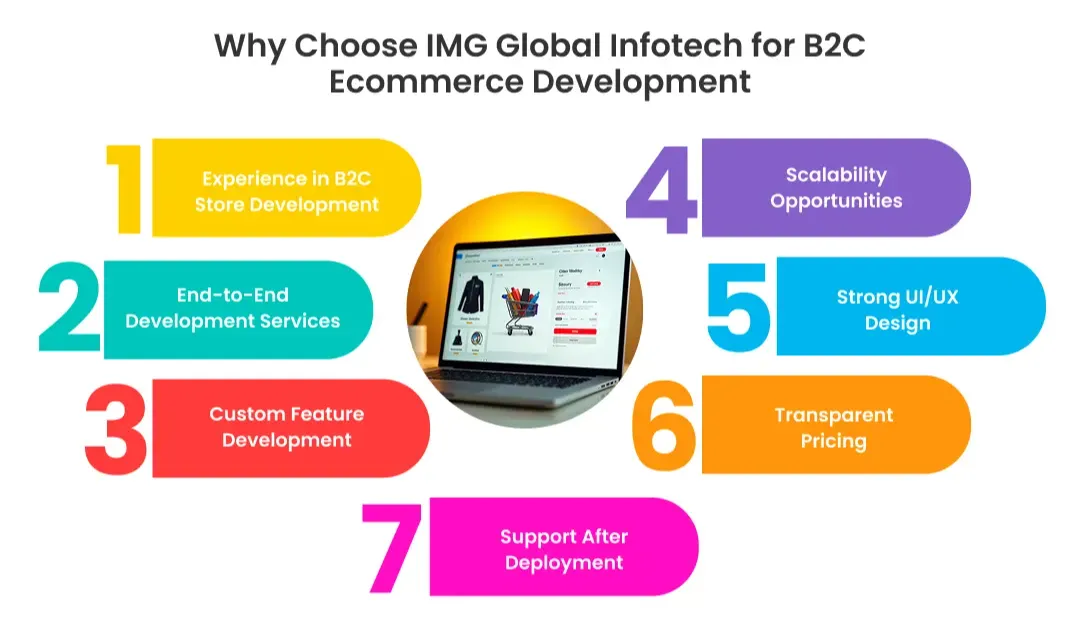
Choosing the right B2C ecommerce website development company could be a make-or-break for your business. The IMG Global Infotech, a reputed development company, can help you build a dynamic, secure, high-performance online store. They have the expertise in B2C store development, with end-to-end development services. They will provide customised feature development, scalable architecture, along with powerful UI and UX design. What you will get at the IMG Global Infotech is listed below:
Experience in B2C Store Development
The IMG Global Infotech understands the B2C store development complexities. They are experienced in providing seamless user experience and backend scalability.
End-to-End Development Services
Hire Shopify Experts or ecommerce website developers from IMG Global Infotech, as they help you in planning, designing, developing, integrating, and deploying. Not just that, they will also support after launch and provide long-term maintenance for scalability.
Custom Feature Development
They help you in building a website with advanced features matched with your business aims.
Scalability Opportunities
They will build a platform that has the potential to scale and grow. Whether you are a small business or a big unit, their architecture makes sure there will be smooth scaling in the future.
Strong UI/UX Design
They will focus on the designs that are conversion-driven and customer-centric. With this ability, your business will have the opportunity to engage the customers, and the chances of retention will also increase.
Transparent Pricing
This is something every business will look at. The IMG Global Infotech provides all the development services at marketable prices, along with long-term maintenance and support.
Support After Deployment
As said in the earlier point, their work does not end just after the launch and deployment part. Partnering with the IMG Global Infotech means your website stays secure, optimised, and up to the mark.
Conclusion
Having an online store is not an option anymore. It is the need of the hour for businesses as it is a powerful tool to reach a wider audience, improve conversions, streamline operations and build a strong business identity digitally. 2026 is the year of endless opportunities for online sellers. From choosing the right b2c ecommerce website development to identifying important features, estimating costs, and following a structured development, we hope that this guide has helped you in every aspect. If you have a plan in your mind about the online store, now is the time. Know your business goals and needs, and based on that, make an ecommerce development cost budget. With the right technology and the right partner, your website can become a high-growth digital asset in the upcoming few years.
Mohit Mittal is the co-founder of a leading IT company with over a decade of experience in driving digital transformation and innovative tech solutions. With a strong background in software development, Mobile app development, E-commerce, business strategy, and team leadership, Mohit Mittal is passionate about helping businesses scale through technology. When not solving complex tech challenges, he enjoys sharing insights on emerging trends, entrepreneurship, and the future of IT.




